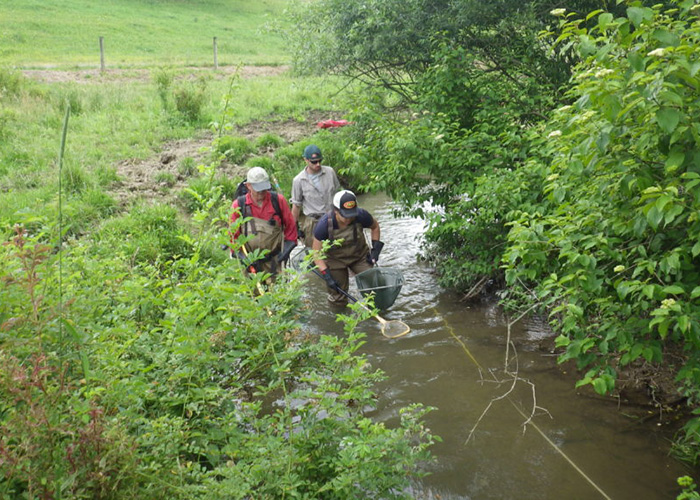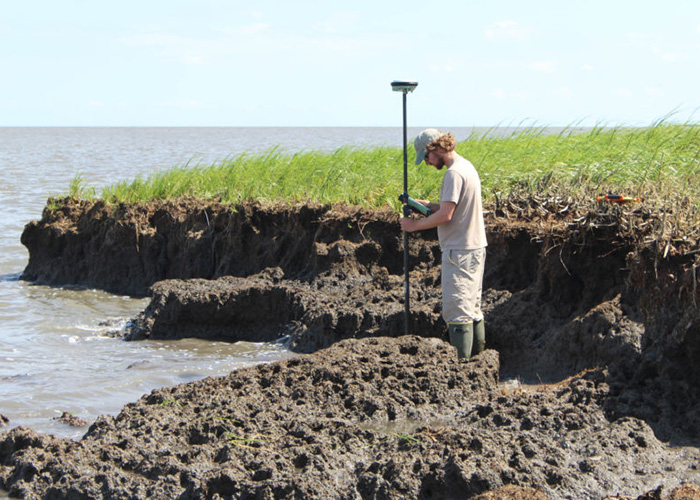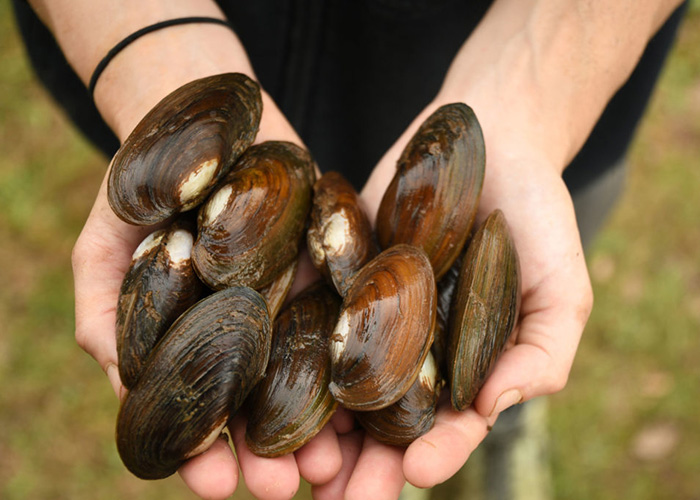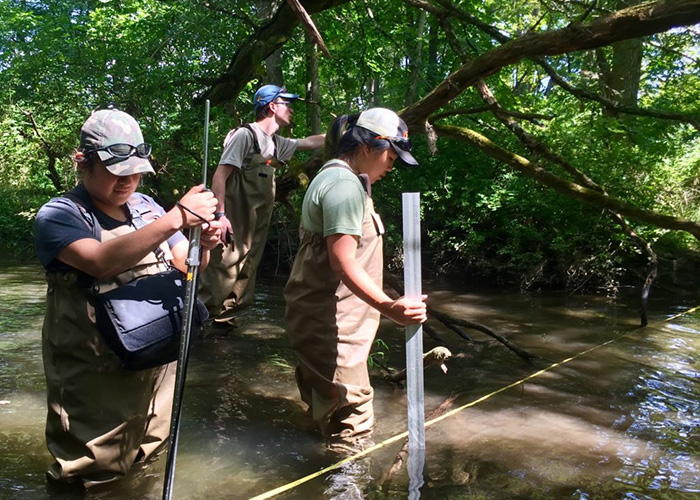Keeping Tabs on the Environment
August 02, 2019
Summertime means the height of field work season for many Academy scientists. They can be found up and down the Delaware River watershed measuring fish, collecting algae samples, measuring sea level rise due to climate change, testing water for the presence of harmful chemicals and more.
Wading in cool streams, hiking bucolic trails, walking through wetlands, and boating to find the fish are all involved. But so are smacking mosquitoes, sweating in waders, battling sun burn, and lugging equipment in heat and humidity.
But all in all our scientists agree: it beats sitting in the office! Here is a sampling of the locations and research projects they are working on this summer.
 Academy scientists (from left) Tess Hooper, Amanda Chan and Brendan Marencin take measurements and collect algae samples at Northkill Creek in Upper Tulpehocken Township, Berks County.
Academy scientists (from left) Tess Hooper, Amanda Chan and Brendan Marencin take measurements and collect algae samples at Northkill Creek in Upper Tulpehocken Township, Berks County.
Algae Sampling and Habitat Assessment
Where: Select streams in suburban Philadelphia, North Jersey, South Jersey, counties of Montgomery, Berks, Chester, Carbon and Monroe, and the Poconos
As part of the Delaware River Watershed Initiative, funded by William Penn Foundation, our scientists monitor communities of organisms in streams and test water quality in response to multi-scale conservation efforts to ensure clean drinking water for millions of people.
What does algae tell us? Algae are sensitive indicators of pollution. Analyzing algal communities gives us a much clearer picture of what impacts there have been on a body of water than we could get from chemistry alone. This technique was originated by the Academy. Algae are used by all the regulatory agencies when assessing streams.
 Academy scientists (from left) Paul Overbeck, Chris Vito and Amanda Chan electrofish at Manor Creek in Albany Township, Berks County. Photo by Allison Stoklosa
Academy scientists (from left) Paul Overbeck, Chris Vito and Amanda Chan electrofish at Manor Creek in Albany Township, Berks County. Photo by Allison Stoklosa
Fish Sampling
Where: Rivers and lakes in the Poconos, South Jersey, Paulinskill, N.J., Montgomery County
What do fish tell us? Fish are excellent indicators of long-term ecosystem health. The compositions of fish communities (which species are present), the health of individual fish, the presence of invasive species, and other fish characteristics can show the condition of the ecosystem over time. Because fish take a longtime to grow and mature (compared to algae and insects), they tell us how long problems have been occurring and their severity.
 Wetlands Project Coordinator Kirk Raper uses an RTK GPS to measure significant coastline erosion at Bombay Hook National Wildlife Refuge. Photo by Rockwell Geyer
Wetlands Project Coordinator Kirk Raper uses an RTK GPS to measure significant coastline erosion at Bombay Hook National Wildlife Refuge. Photo by Rockwell Geyer
Seal level rise
Where: Tinicum National Wildlife Refuge
What does sea level rise tell us? Sea level rise is major indicator of climate change and its impacts. This work involves extremely precise measurements taken in marshes to determine water depths. The locations are also precisely determined and returned to year after year to understand trends and changes.
 Once plentiful in the Delaware River watershed, mussels help keep rivers, streams and ponds clean by filtering particles out of the water. Photo by Roger Thomas/ANS
Once plentiful in the Delaware River watershed, mussels help keep rivers, streams and ponds clean by filtering particles out of the water. Photo by Roger Thomas/ANS
Mussels
Why? The Academy and partners are doing a novel approach to increasing mussel populations in the Delaware River and in the watershed. They are growing mussels in the lab then planting them in nature.
What do mussels tell us? Mussels clean the water. They had been in decline in the Delaware and are making a slow comeback. Scientists agree for the need to increase the population to help clean the water. We’ll check on the progress of mussels growing in lab, measure them for growth and health. More information on this project can be found on the Academy Blog.
 Eli Escobar (from left), a student in the Women In Natural Sciences program, volunteer Matt Tursi, and Academy field team leader Amanda Chan measure the depth and flow rate of the water and the vegetation as part of a fish survey at Cherry Creek near Stroudsburg. Photo by Allison Stoklosa
Eli Escobar (from left), a student in the Women In Natural Sciences program, volunteer Matt Tursi, and Academy field team leader Amanda Chan measure the depth and flow rate of the water and the vegetation as part of a fish survey at Cherry Creek near Stroudsburg. Photo by Allison Stoklosa
By Roland Wall, director of the Patrick Center for Environmental Research, and Kathryn Christopher, manager of science communication and outreach